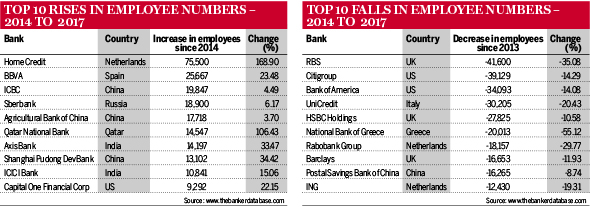Big European and US banks continue to set the benchmark for cutting headcount, as rising regulatory costs force them to improve efficiencies to boost profits.
Citigroup recently announced that its multi-year restructure is over, so its downsizing may be drawing to an end. UniCredit, on the other hand, is upping the ante. After steadily shrinking headcount since 2010, last year it axed 15.64% of its workforce and announced a new strategic plan that involves slashing 14,000 jobs by 2019.
Somewhat surprisingly, European-headquartered banks set the pace for hiring. BBVA’s number two ranking is due to its acquisition of CatalunyaBanc and Turkiye Garanti Bankasi’s new classification as a subsidiary. But the year’s big story is Home Credit. The 585th-ranked Dutch bank sells small short-term loans for household items to customers with little or no credit history. In 2016 its headcount soared 65% after bulking up in India, China and Indonesia.
Another surprise is that Qatar National Bank, the Middle East’s biggest bank, has more than doubled its staff since the beginning of the oil rout in 2014. It added 85% more employees last year alone, although this may be partly down to its acquisition of National Bank of Greece’s Turkish subsidiary Finansbank.
Russia’s biggest lender, Sberbank, shed more than 5000 jobs in 2016, but its exponential rise in staff numbers over the 24 months prior means it still ranks fourth in the list of biggest hirers. Meanwhile, Chinese banks’ headcount is still growing but, as with their capital levels, at a slower rate than previously. Two years ago they claimed eight of the top 10 spots for rising headcount, but this year there are only three names.
Postal Savings Bank of China is an interesting exception. It cut nearly 10% of its workforce in 2016, a much-needed measure given it had three times as many employees as similar-sized Chinese banks. It became a public company in September 2016, so may face more pressure to improve efficiencies and accountability, and therefore downsize more swiftly going forward.
It is striking that the biggest increases in employee numbers are significantly lower than a few years ago, suggesting the biggest banks are not only reaching their natural limit in terms of capital and assets, but also of their workforce.
For extended coverage of The Banker's Top 1000 World Banks 2017, click here



